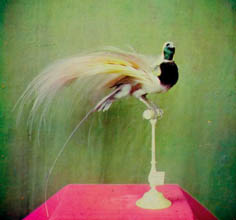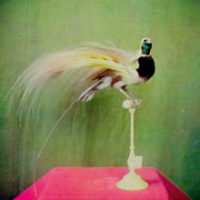Category: PAST EXHIBITIONS
EXHIBITIONS
May 7, 2004 – June 5, 2004
November 30, 2006 – January 7, 2007
September 9, 2010 – October 1, 2010
From the 09—14 September, the Gallery Daniel Blau will be having a set of consecutive exhibitions by four exponents of the LE GUN artists collective: Robert Rubbish, Chris Bianchi, Stephanie von Reiswitz and Bill Bragg. Founding members of the LE GUN group and the publication of the same name, these London-based artists are united by the medium of illustration on paper.
9 September, 11—18 pm: Stephanie von Reiswitz
Munich-born and very much immersed in the London universe, Stephanie von Reiswitz depicts surreal tales of past glories and tragedies, while rendering through her sombre colours and shapes an aesthetic reminiscent of the Weimar Republic.
10 September, 18—21 pm: Chris Bianchi
A self-invented Maltesian, Chris Bianchi’s somewhat surreal ideas are rendered in landscapes where new perspectives lead onto more and the viewer will find their mind pleasantly boggled.
11 September, 11—18 pm: Robert Rubbish
A unique Londoner and notorious Soho character, Robert Greene (a.k.a. Robert Rubbish), comprises half of the Victorian punk revivalist duo, the Rubbish Men, and shares generously a slice of his world through an adventurous synthesis of drawings and writing.
12 September, 11—18 pm: Bill Bragg
An illustrator with an appreciation for the deeper shades that a pencil can afford, this Englishman depicts fragmentary tales of mystery and conjures unlikely characters in a beautifully noir-esque style.
After the Open Art Galerie Daniel Blau presents a group exhibition of all the members of LE GUN including Neal Fox, who already had two very successful solo shows at Galerie Daniel Blau.
May 5, 2011 – June 3, 2011
“The bare facts speak for themselves: born in Berlin in 1922 and now generally regarded as the greatest living English painter, espeialle of people, both female and male. The artist’s father Ernst Ludwig Freud, a German architect, was the son of the great Sigmund Freud. After his fathers’s death in London in 1970, Lucian commenced a remarkable series of paintings of his mother Lucie Brasch, around ten in all, as well as a munber of drawings and etchings. Lucie was the daughter of a prosperous grain merchant from the Baltic coast and what is perhaps one of the earliest of these head-and shoulder paintings foms the centrepiece in this exhibition. The painting seems to anticipate what is certainly the finest – and in England most controversial – portrait of Quenn Elizabetg II, a similarly small, head-and-shoulder depiction of a great, if stern, mother figure.
The faces of Freud’s sitters nearly always exude a sense of inward reflection. They seem lost in their own reverie which the artist constantly observes and describes. For Lucian Freud flattery is never an issue, nor is moral judgement nor psychological analysis. There is also no sense of caricature or mockery at the human condition either, as one might find in the work of the artist Otto Dix. Wheter the sitter is staring at the artistm looking down or even looking away, an almost inevitable sense of melancholy prevails, as the artist captures what in essence is a fleeting and ephemeral moment – paradoxically over as many as a hundred sittings – immortalised on that unpredictable path from one instance to the next. That is perhaps part of the beauty and attraction of all attempts at painting or drawing reality and the special quality of psychological portraiture.” – Exerpt from the essay by Norman Rosenthal, published in Lucian Freud: Portraits, Hirmer/Daniel Blau(ed.), Germany, 2011.
April 7, 2011 – April 30, 2011
“Though the poetics of the atomic sublime might reassuringly couch its explosive potential in the language of nature, still it was a product of man, of culture.”
This inaugural exhibition at Daniel Blau’s London gallery makes a particular statement about the development and positioning of vintage photography. We wish to present you with an historically grounded, extraordinarily beautiful set of photographs that have come to stand as powerful visual icons, representing a salient period of international politics: The Cold War.
The image of the atomic bomb is one of unique and horrific beauty: The pictures of atomic bomb explosions – ranging from New Mexico USA, to the actual and affecting George R. Caron photographs shot from a military plane over Hiroshima – stand as representations of the difference between sublime artwork and frightful document.
This exhibition incorporates a variety of photographs, including US Navy and Air Force images of nuclear bomb tests by Edgerton and Eyerman – the former a scientific photographer and the latter with tendencies towards surrealism. This unique and historic collection of images span the period 1945 – 1970 to form a visual narrative full of power, horror and agressive beauty.
This exhibition is accompanied by a 48-page newspaper publication available from the gallery.
November 14, 2007 – November 18, 2007
Galerie Daniel Blau is proud to announce the exhibition “Autochromes — The Rise of Colour Photography” at Galerie Meyer, Rue des Beaux Arts, Paris.
100 years have now passed since the first commercially applicable method of colour photography was introduced. The method of colouring potato starch and making it light sensitive was publicized by the Lumière brothers in 1907 under the name “Autochrome”. Fixed on a glass-plate, this process resulted in the first coloured photographs one century ago. The variable grain in Autochromes is still of central importance to today’s photography — digital photography, colour printing and silk screens are based on it.
Even in their early stages, Autochromes were compared to the paintings of the pointilists and one can not help but be reminded of works of impressionism when taking in the strength of the colours and the painting-like depth of these impressions on glass.
This important collection, assembled over many years from dealers and fellow collectors worldwide, is now on view to the public for the first time. Using especially designed presentation frames, Daniel Blau will be exhibiting his significant collection of Autochromes, dating from 1895 to 1920, in the exhibition rooms of Galerie Meyer. Among other photographers, the images of such famous artists as Lumière, Gimpel and Knott will be shown. Atmospheric scenes of Parisian alleys hang by lively squares; large parks by lonely ruins; rugged cliffs can be viewed alongside calm ocean bays, while the intimate effect of the intense colours draws the viewer in.







 +49 89 29 73 42
+49 89 29 73 42